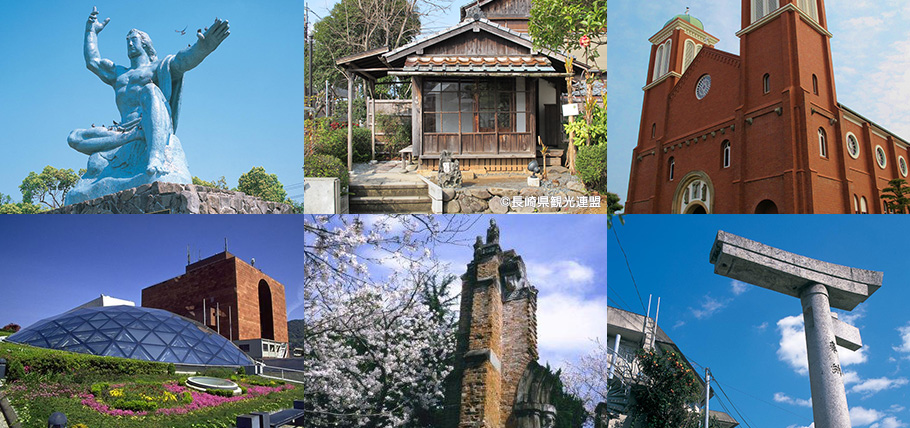Peace Park Course (2 hours)

At 11:02 on August 9, 1945, an atomic bomb exploded in Nagasaki, killing many innocent civilians.
The remains of the atomic bombing in the vicinity of Peace Park still bear witness to the threat of the atomic bombing. Under the slogan "Nagasaki as the last A-bombed city," the city of Nagasaki continues to appeal for peace to the world.
This course allows visitors to "see, know, and feel" the threat of the atomic bombings and the preciousness of peace.
Minimum number of applicants: 3 (for visitors to Japan: 4)
*If you have children under 12 years old, please enter their ages and the number of children in the "Communication" field.
departure time
| 1 | Departure 9:00 Return 11:00 (tentative) |
|---|---|
| 2 | Departure 13:00 Return 15:00 (tentative) |
Course Content
| 09:00 (13:00) | Departure: Nagasaki Station area |
| 09:10 (13:10) | (1) Peace Park |
| 09:30 (13:30) | (2) Nyokodo (from car window) |
| 09:35 (13:35) | Urakami Tenshudo (from car window) |
| 09:40 (13:40) | Nagasaki Atomic Bomb Museum |
| 10:20 (14:20) | (5) Atomic bomb drop center (from car window) |
| 10:30 (14:30) | (6) Single Pillar Torii (from car window) |
| 10:40 (14:40) | (7) Martyrdom of the 26 saints |
| 11:00 (15:00) | Arrival: Nagasaki Station area |
Tour Fees
one person3,500Yen (incl. tax)Highlights of this course
-
(1) Peace Park
The right hand pointing to the heavens expresses the horror of the atomic bombing, the horizontally outstretched left hand expresses peace, and the closed eyes express the hope that the victims of the atomic bombing will rest in peace. The Peace Statue by the late Seibo Kitamura, a native of Nagasaki Prefecture, and other monuments presented by various countries are a silent protest against the atomic bombing and a wish for eternal peace. -
(2) Nyokodo (from car window)
The Nagai Takashi M.D. Memorial Hall is dedicated to Dr. Takashi Nagai, who suffered from leukemia caused by the atomic bombing, but continued to work for peace and to help A-bomb survivors. In this hall, which means "love your neighbor as yourself," Dr. Nagai wrote such famous works as "Leave This Child Behind" and "The Bells of Nagasaki," and appealed for peace far and wide, even to foreign countries. -
Urakami Tenshudo (from car window)
After the prohibition was lifted in 1873, it took 33 years under the leadership of Father Freneau, a French missionary, to build the largest Romanesque church in the East. However, it was destroyed by the atomic bomb. It was rebuilt in 1959, and the bell of Angelus, the "Bell of Nagasaki," which survived the war, continues to ring out a plaintive prayer for peace. -
Nagasaki Atomic Bomb Museum
The museum was newly opened in 1996. The museum exhibits the history of the atomic bombings, materials on the damage, and nuclear weapons in an easy-to-understand manner using photographs and models. The museum also makes strong appeals to the world's anti-nuclear movement and human rights issues. The museum also has a wide ramp to accommodate visitors with physical disabilities. -
(5) Atomic bomb drop center (from car window)
August 9, 1945, 11:02 a.m. An atomic bomb exploded about 500 meters above the park. In 1997, the park was newly landscaped and became a place of recreation and relaxation for the citizens, and colorful one thousand folded paper cranes on the central monument convey the message of peace. -
(6) Single Pillar Torii (from car window)
Half of the torii gate of Sanno Shrine, which was located approximately 900 meters from the hypocenter, was ripped off in the blast. It still stands today as it was when it survived the tragedy of the atomic bombing. Its appearance seems to be a silent appeal for the preciousness of peace. -
(7) Martyrdom of the 26 saints
This museum stands on Nishizaka Hill, the site of the martyrdom of six foreign missionaries and twenty Japanese believers, the twenty-six saints. In the exhibition room, the history of Christian missionary work in Japan from Xavier's missionary work, the period of oppression, the martyrdom of the 26 saints, the prayers of the Christians in hiding, and the revival of the faith during the Meiji period are introduced through numerous documents.